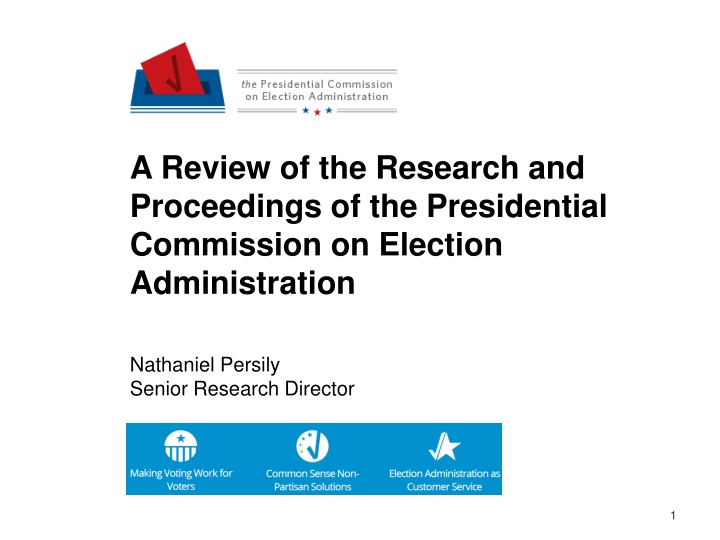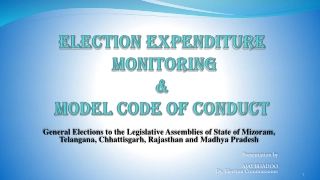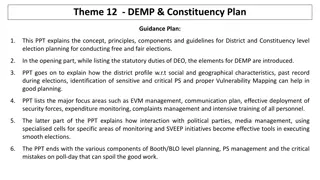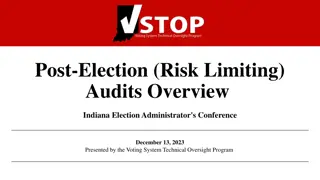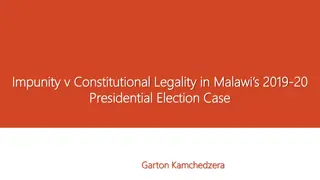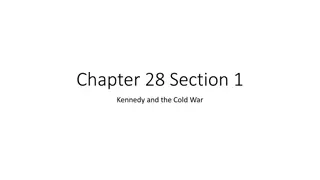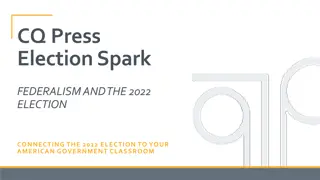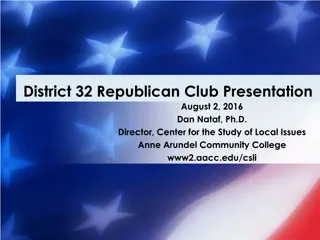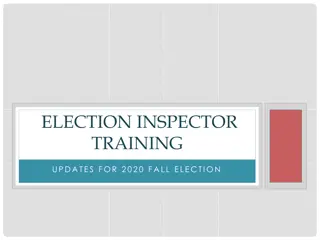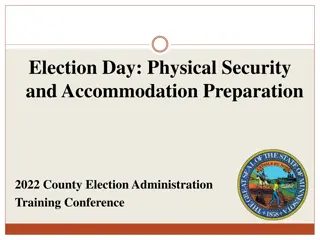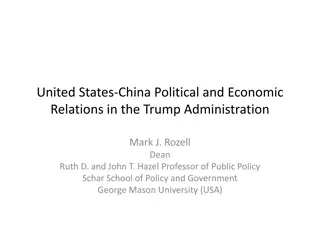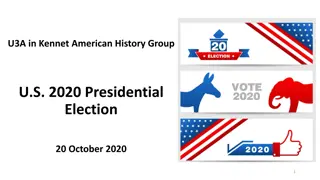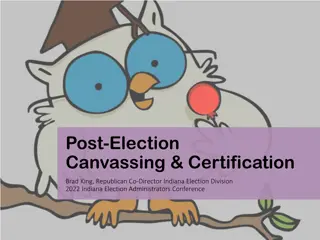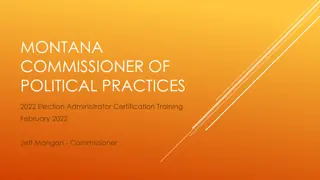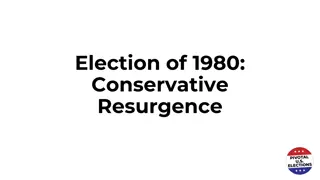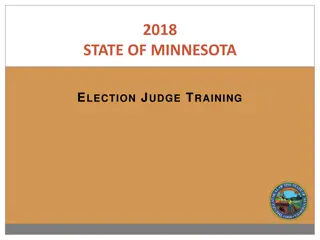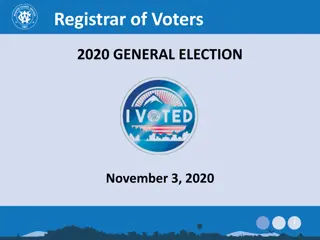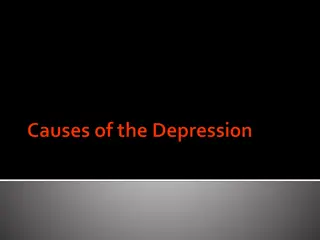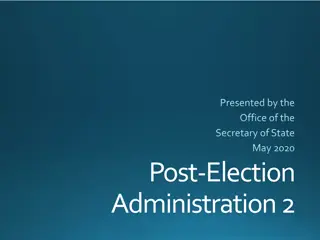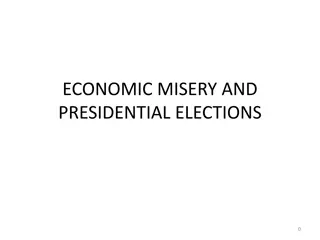Review of Presidential Commission on Election Administration Proceedings
Detailed overview of the research and proceedings of the Presidential Commission on Election Administration, including goals identified, work methods, public hearings, meetings with election officials, and assistance from academic leaders.
Download Presentation

Please find below an Image/Link to download the presentation.
The content on the website is provided AS IS for your information and personal use only. It may not be sold, licensed, or shared on other websites without obtaining consent from the author.If you encounter any issues during the download, it is possible that the publisher has removed the file from their server.
You are allowed to download the files provided on this website for personal or commercial use, subject to the condition that they are used lawfully. All files are the property of their respective owners.
The content on the website is provided AS IS for your information and personal use only. It may not be sold, licensed, or shared on other websites without obtaining consent from the author.
E N D
Presentation Transcript
A Review of the Research and Proceedings of the Presidential Commission on Election Administration Nathaniel Persily Senior Research Director 1
Review of the Goals Identified in the Executive Order Promote the efficient administration of elections: o To ensure that eligible voters have the opportunity to cast their ballots without undue delay o To improve the experience of voters facing other obstacles in casting their ballots, such as members of the military, overseas voters, voters with disabilities, and voters with limited English proficiency. 2
How the Commission went about its work Public Meetings and Hearings Meetings with groups and organizations of election officials Submission of testimony and other material through website: www.supportthevoter.gov Subcommittee 3
Public Hearings Initial Public Meeting Washington, DC, June 21 Four public hearings o Miami, FL, June 28 o Denver, CO, Aug. 8 o Philadelphia, PA, Sept. 4 o Cincinnati, OH, Sept. 19-20 Format o Election Officials o Academics and other Experts o General Public 4
Meetings with groups and organizations of election officials o Election organizations: IACREOT, NASS, NASED, FOCE, NCSL, Election Center, EAC o Other groups: The Heritage Foundation, the Brookings Institution, the Lawyers Committee for Civil Rights, the Bipartisan Policy Center, the Republican National Lawyers Association, the PEW Voter Information Project, Alaska Federation of Natives, the Asian-American Legal Defense and Education Fund, LatinoJustice-PRLDEF, the Military Voter Protection Project, FVAP, Overseas Vote Foundation, the Brennan Center, the National Council on Disability, and the U.S. Postal Service o Meetings discussed on public meeting conference call on November 14. 5
Assistance of Academics Leadership: o Charles Stewart, Daron Shaw, Steve Ansolabehere. o About a dozen who presented research to commission Conducted nationwide survey of local election officials 6
Specified Factors that Affect the Achievement of the Goals of the EO Promote the efficient administration of elections: To ensure that eligible voters have the opportunity to cast their ballots without undue delay Management of polling place, poll workers and voter rolls Voting machine capacity and technology Ballot simplicity and voter education Provisional ballots To improve the experience of voters facing other obstacles in casting their ballots Members of the military Overseas voters Voters with disabilities Voters with limited English proficiency Absentee voters Victims of natural disasters or emergencies 7
Threshold Challenges for Commissions Report and Recommendations Scope of the Charge One size does not fit all Resources Data Vacuum Macro v. micro recommendations e.g., reforms of voter registration v. ballot font size Gaps in enforcement of existing laws: NVRA, ADA, HAVA, VRA (section 203), UOCAVA, MOVE Wealth of material already out there o EAC reports and quick start guides o Election Center 2000 and 2004 Best Practices Reports o NASS/NASED e.g, task force report on natural disasters o AIGA on ballot design 8
Election Day Lines Standard: How long is long? : 1 hour? Half hour? No standard? Factors that affect line length o Poor planning o Polling places, staff, machines o Resource misallocation o Voter s preparation o Ballot length and complexity 9
New challenges Technology o Potentially widespread, simultaneous failure of HAVA- purchased machines o Market breakdown o Standards/Certification breakdown o Dissatisfaction from both vendors and clients Problem of Facilities o Scarcity and Accessibility o School Security Concerns Mail o Importance for increasing use of vote-by-mail o Reduction in service o Uniformity of postal service policy 10
Management of Voter Rolls Problem: o Registration lists cannot keep up with mobility of American population o Millions of registrations out of date o Lack of integration of DMV and voter registration databases o Cost of maintaining voter rolls 11
Challenges faced by particular groups Military and Overseas voters Voters with disabilities Voters with limited English proficiency Absentee voters Victims of natural disasters or emergencies 12
Military and Overseas Problem Improvement since MOVE But also confusion: o States vary: how long a ballot application through the Federal Postcard Application (FPCA) remains in effect o Whether a Federal Write-in Absentee ballot (FWAB) also counts as a voter registration application State Websites inadequate IVAOs inadequate Fear by military officials about getting involved in politics 13
Voters with disabilities Problem Increase in size of population with accessibility needs Inaccessible polling places Untrained poll workers Technology with accessibility not baked-in Bans on voting for those with cognitive disabilities Need for training Usability testing 14
Limited English Proficiency Voters Problem Lack of enforcement of Section 203 of VRA Shortage of bilingual poll workers Confusing ballots Longer voting times/lines Unwritten languages 15
Absentee Ballots Problem Lost votes at multiple stages of process Mail problems Increase in provisionals due to permanent absentee voters voting in polling place Greater opportunity for fraud 16
Victims of Natural Disasters Problem Lack of statutory guidance as to when elections can be rescheduled and who is in charge on Election Day in the event of a disaster Lack of planning Lack of process to protect voting rights of first responders 17
